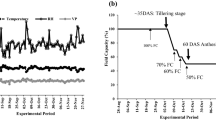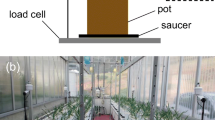Abstract
Genotypic and environmental (soil water regime and N level) variation in carbon isotope discrimination (CID) in relation to the gas exchange, transpiration efficiency (A/T), and biomass production were investigated in field experiments using eleven rice (Oryza sativa L.) genotypes. The results showed that genotype was more dominant for variation in CID than in total biomass. Genotypic ranking in CID was consistent across environments because of small genotype × environment interactions. Japonica genotypes tended to have lower CID than indica genotypes. Higher soil water and lower N rate significantly increased CID. Variation in CID was slightly smaller for water regime than for genotype. There was a negative correlation between CID andA/T among genotypes within water regimes. Genotypic variation in CID was associated mainly with variation in stomatal conductance under all soil water regimes and with photosynthetic capacity in late growth stages under aerobic soil conditions. The decrease in CID at higher N was probably due to lower stomatal conductance under aerobic soil conditions and to higher photosynthetic rates under submerged soil conditions. The correlation between biomass and CID was not clear in aerobic soil, whereas it was positive in submerged soil, which indicated that the significance of lower or higher CID for improving biomass productivity may differ under different soil water regimes. Overall, the results implied a possible use of CID as a selection criterion for genotypic improvement inA/T and productivity in rice.
Similar content being viewed by others
Abbreviations
- A :
-
net photosynthetic rate
- A/T :
-
transpiration efficiency
- Ci/Ca :
-
leaf intercellular CO2 concentration/ambient CO2 concentration ratio
- CID:
-
carbon isotope discrimination
- gs :
-
stomatal conductance
- HI:
-
harvest index
- SLW:
-
specific leaf weight
- T :
-
transpiration rate
References
Acevedo E 1993 Potential of carbon isotope discrimination as a selection criterion in barley breeding.In Stable Isotopes and Plant Carbon-Water Relations. Eds. J R Ehleringer, A E Hall and G D Farquhar. pp. 339–710. Academic Press, San Diego, CA.
Angus J F S, Hasegawa S, Hsiao T C, Liboon S P and Zandstra H G 1983 The water balance of post-monsoonal dryland crops. J. Agric. Sci. 101, 699–710.
Araus J L, Villegas D, Aparcio N, Moral L F G, Hani S E, Rharrabti Y, Ferrio J P and Royo C 2003 Environmental factors determining carbon isotope discrimination and yield in durum wheat under Mediterranean conditions. Crop Sci. 43, 170–180.
Clay D E, Engel R E, Long D S and Liu Z 2001 Nitrogen and water stress interacts to influence carbon-13 discrimination in wheat. Soil Sci. Soc. Am. J. 65, 1823–1828.
Condon A G and Richards R A 1992 Broad-sense heritability and genotype × environment interaction for carbon isotope discrimination in field-grown wheat. Aust. J. Agric. Res. 43, 921–934.
Condon A G, Farquhar G D and Richards R A 1990 Genotypic variation in carbon isotope discrimination and transpiration efficiency in wheat. Leaf gas exchange and whole plant studies. Aust. J. Plant Physiol. 17, 9–22.
Condon A G, Richards R A and Farquhar G D 1987 Carbon isotope discrimination is positively correlated with grain yield and dry matter production in field-grown wheat. Crop Sci. 27, 996–1001.
Condon A G and Richards R A 1993 Exploiting genetic variation in transpiration efficiency in wheat: An agronomic view.In Stable Isotopes and Plant Carbon-Water Relations. Eds. J R Ehleringer, A E Hall and G D Farquhar. pp. 435–450. Academic Press, San Diego, CA.
Condon A G, Richards R A, and Farquhar G D 1992 The effect of variation in soil water availability, vapour pressure deficit and nitrogen nutrition on carbon isotope discrimination in wheat. Aust. J. Agric. Res. 43, 935–947.
Courtois B and Lafitte R 1999 Improving rice for drought-prone upland lowland environments.In Genetic improvement of rice for water-limited environments. Eds. O Ito, J C O’Toole and B Hardy. pp. 35–56. International Rice Research Institute, Los Baños, Philippines.
Craufurd P Q, Austin R B, Acevedo E and Hall M A 1991 Carbon isotope discrimination and grain-yield in barley. Field Crops Res. 27, 301–313.
Dingkuhn M, Cruz R T, O’Toole J C and Dorffling K 1989 Net photosynthesis, water use efficiency, leaf water potential and leaf rolling as affected by water deficit in tropical upland rice. Aust. J. Agric. Res. 40, 1171–1181.
Dingkuhn M, Farquhar G D, De Datta S K and O’Toole J C 1991 Discrimination of13C among upland rices having different water use efficiency. Aust. J. Agric. Res. 42, 1123–1131.
Ehleringer J R 1990 Correlations between carbon isotope discrimination and leaf conductance to water vapor in common beans. Plant Physiol. 93, 1422–1425.
Farquhar G D, Ehleringer J R and Hubick K 1989 Carbon isotope discrimination and photosynthesis. Ann. Rev. Crops Res. 40, 67–86.
Farquhar G D, Oleary M H and Berry J A 1982 On the relationship between carbon isotope discrimination and the intercellular carbon dioxide concentration in leaves. Aust. J. Plant Physiol. 9, 121–202.
Farquhar G F, Condon A G, and Masle J 1994 Use of carbon and oxygen isotope composition and mineral ash content in breeding for improved rice production under favorable, irrigated conditions.In Breaking the yield barrier. Ed. K G Cassman. pp. 95–101. International Rice Research Institute, Los Baños, Philippines.
Farquhar G D and Richards R A 1984 Isotope composition of plant carbon correlated with water-use efficiency of wheat genotypes. Aust. J. Plant Physiol. 11, 539–552.
Fischer R A, Rees D, Sayre K D, Lu Z M, Condon A G and Larque Saavedra A 1998 Wheat yield progress associated with higher stomatal conductance and photosynthetic rate, and cooler canopies. Crop Sci. 38, 1467–1475.
Glaszmann J C 1987 Isozymes and classification of Asian rice varieties. Theor. Appl. Genet. 74, 21–30.
Gleixner G, Danier H J, Werner R A, and Schmit H L 1993 Correlations between the13C content of primary and secondary plant product in different cell compartments and that in decomposing basidiomycetes. Plant Physiol. 102, 1287–1290.
Hall A E, Ismail A M and Mendez C M 1993 Implications for plant breeding of genotypic and drought-induced differences in water-use efficiency, carbon isotope discrimination, and gas exchange.In Stable Isotopes and Plant Carbon-Water Relations. Eds. J R Ehleringer, A E Hall and G D Farquhar. pp. 349–369. Academic Press, San Diego, CA.
Hall A E, Richards R A, Condon A G, Wright G C and Farquhar G D 1994 Carbon isotope discrimination and plant breeding. Plant Breeding Rev. 12, 81–113.
Hall A E, Mutters R G, Hubick K T and Farquahr G D 1990 Genotypic differences in carbon isotope discrimination by cowpea under wet and dry field conditions. Crop Sci. 30, 300–305.
Heitholt J, Johnson R C and Feris D M 1991 Stomatal limitation to carbon dioxide limitation in nitrogen- and drought-stressed wheat. Crop Sci. 31, 135–139.
Hubick K T 1990 Effects of nitrogen source and water limitation on growth, transpiration efficiency and carbon-isotope discrimination in peanut cultivars. Aust. J. Plant Physiol. 17, 413–430.
Hubick K T and Farquhar G D 1989 Carbon isotope discrimination and the ratio of carbon gained to water lost in barley cultivars. Plant Cell Environ. 12, 795–804.
Hubick K T, Shorter R, and Farquhar G D 1988 Heritability and genotype × environment interactions of carbon isotope discrimination and transpiration efficiency in peanut. Aust. J. Plant Physiol. 15, 799–813.
IRRI 1997 Rice Almanac, International Rice Research Institute, Los Baños, Philippines.
Kondo M, Aguilar A, Abe J and Morita S 2000 Anatomy of nodal roots in tropical upland and lowland rice varieties. Plant Prod. Sci. 3, 437–445.
Kuroda E and Kumura A 1990 Difference in Single Leaf Photosynthesis between old and New Rice; I. Single-leaf photosynthesis and its dependence on stomatal conductance. Jpn. J. Crop Sci. 59, 83–292.
Lilley J M and Fukai S 1994 Effect of timing and severity of water deficit on four diverse rice cultivars. I. Rooting patterns and soil water extraction. Field Crops Res. 37, 205–214.
Martin B, Tauer C G and Lin R K 1999 Carbon isotope discrimination as a tool to improve water-use efficiency in tomato. Crop Sci. 39, 1775–1783.
Maruyama S, Kabaki N and Tajima K 1985 Water consumption in japonica and indica rice varieties. Jpn. J. Crop Sci. 54, 32–38.
Melzer E and O’Leary M H 1987 Anapeurotic CO2 fixation by phosphoenolpyruvate carboxylase in C3 plants. Plant Physiol. 84, 58–60.
Merah O, Deleens E, Souyris I, Nachit M and Monneveux P 2001 Stability of carbon isotope discrimination and grain yield in drum wheat. Crop Sci. 41, 677–681.
Morgan J A, LeCain D R, McCaig T N and Quick J S 1993 Gas exchange, carbon isotope discrimination, and productivity in winter wheat. Crop Sci. 33, 173–186.
Nageswara Rao R C and Wright G C 1994 Stability of the relationship between specific leaf area and carbon isotope discrimination across environments in peanut. Crop Sci. 34, 98–103.
Peng S, Laza R C, Khush G S, Sanico A L, Visperas R M and Garcia F V 1998 Transpiration efficiencies of indica and improved tropical japonica rice grown under irrigated conditions. Euphytica 103, 103–108.
Rebetzke G J, Condon A G, Richards R A and Farquhar G D 2002 Selection for reduced carbon isotope discrimination increased aerial biomass and grain yield of rainfed bread wheat. Crop Sci. 42, 739–745.
Samejima M 1985 Intraspecific variations of13C discrimination inOryza sativa L. Bull. Natl. Inst. Agrobiol. Resource 1, 63–84 (Japanese with English summary).
Saranga Y, Flash I, Paterson A H and Yakir D 1999 Carbon isotope ratio in cotton varies with growth stage and plant organ. Plant Sci. 142, 47–56.
Voltas J, Romagosa I, Lafarga A, Armesto A P, Sombrero A and Araus J L 1999 Genotype by environment interaction for grain yield and carbon isotope discrimination of barley in Mediterranean Spain. Aust. J. Agric Res. 50, 1263–1271.
Wright G C, Hubick K T and Farquhar G D 1988 Discrimination in carbon isotopes of leaves correlates with water-use efficiency of field-grown peanut cultivars. Aust. J. Plant Physiol. 15, 815–825.
Wright G C, Hubick K T, Farquhar G D and Nageswara Rao R C 1993 Genetic and environmental variation in transpiration efficiency and its correlation with carbon isotope discrimination and specific leaf area in peanut.In Stable Isotope and Plant Carbon-Water Relations. Eds. J R Ehleringer, A E Hall and G D Farquhar. pp. 247–267. Academic Press, San Diego, CA.
Wright G C, Nageswara Rao R C and Farquhar G D 1994 Wateruse efficiency and carbon isotope discrimination in peanut under water deficit conditions. Crop Sci. 34, 92–97.
Yadav R, Courtois, B, Huang N and McLaren G 1997 Mapping genes controlling root morphology and root distribution in a double-haploid population of rice. Theor. Appl. Genet. 94, 619–632.
Yoshida S and Hasegawa S 1982 The rice root system: its development and function.In Drought Resistance in Crops with Emphasis on Rice. pp. 97–114. International Rice Research Institute, Los Baños, Philippines.
Author information
Authors and Affiliations
Corresponding author
Rights and permissions
About this article
Cite this article
Kondo, M., Pablico, P.P., Aragones, D.V. et al. Genotypic variations in carbon isotope discrimination, transpiration efficiency, and biomass production in rice as affected by soil water conditions and N. Plant Soil 267, 165–177 (2004). https://doi.org/10.1007/s11104-005-4884-6
Received:
Accepted:
Issue Date:
DOI: https://doi.org/10.1007/s11104-005-4884-6




